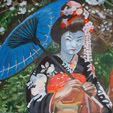Ukiyo-e and the Tan Tartan Mystery
Ukiyo-e (浮世絵), "pictures of the floating world", is a genre of Japanese woodblock prints (or woodcuts) and paintings produced between the 17th and the 20th centuries, featuring motifs of landscapes, the theatre and pleasure quarters. It is the main artistic genre of woodblock printing in Japan.
Ukiyo, meaning "floating world", refers to the impetuous young culture that bloomed in the urban centers of Edo (modern-day Tokyo), Osaka, and Kyoto that were a world unto themselves. It is an ironic allusion to the homophone term "Sorrowful World" (憂き世), the earthly plane of death and rebirth from which Buddhists sought release. The art form rose to great popularity in the metropolitan culture of Edo (Tokyo) during the second half of the 17th century, originating with the single-color works of Hishikawa Moronobu in the 1670s. At first, only India ink was used, then some prints were manually colored with a brush, but in the 18th century Suzuki Harunobu developed the technique of polychrome printing to produce nishiki-e.
Ukiyo-e were affordable because they could be mass-produced. They were meant for mainly townsmen, who were generally not wealthy enough to afford an original painting. The original subject of ukiyo-e was city life, in particular activities and scenes from the entertainment district. Beautiful courtesans, bulky sumo wrestlers and popular actors would be portrayed while engaged in appealing activities. Later on landscapes also became popular. Political subjects, and individuals above the lowest strata of society (courtesans, wrestlers and actors) were not sanctioned in these prints and very rarely appeared. Sex was not a sanctioned subject either, but continually appeared in ukiyo-e prints. Artists and publishers were sometimes punished for creating these sexually explicit shunga.
Here's some examples:
These two are by my favorite, Hokusai. Really famous.


I wasn't allowed to take pictures inside the museum itself, but the exhibition was cool. Many of the pieces were on loan from the Musee Guimet, and the cool part was the reunion of his famous Tiger and Dragon scrolls, which were meant to be viewed together but hadn't been in the same room for most of their existence:

We had to remove our shoes to go up to these scrolls, as they were in a case that had to be viewed while kneeling on tatami mats. It really added to the experience, showing reverence for these great masterpieces. Much better experience than seeing, say, The Mona Lisa at the Louvre, where one has to queue up for miles and quickly file past the (in my opinion, overrated) piece which was behind several inches of bullet-proof glass.
Anyway, most of the pieces were supremely beautiful, except maybe the sumo wrestlers, so I was really surprised to see these two pieces near the end of the exhibit, also by Hokusai:


I found many other super-creepy works in the books in the gift shop, so I guess demons and ghosts were popular subjects also. No one does horror quite like the Japanese, as many have seen in the recent deluge of Japanese horror movies like Ringu (also well-redone by Hollywood) and The Grudge (badly remade).
As I said, I wasn't allowed to take pictures inside, but I did take this one outside as I was waiting in line to go in (about half and hour):

I just liked the lines. Anyway, while I was waiting, I noticed someone wearing a bit of Tan Tartan. Now, I'd noticed this particular color of tartan on many people since I've been here. Mainly, I'd seen it on the scarves of schoolgirls, and I'd wondered if it was a school-uniform thing. But then I noticed it on other people. It was really prevalent. So, I decided that I would see how many people I could find on this trip to Harajuku who were wearing this particular tartan. As you can see, there were a lot. The first two were in line with me, and the rest were out in Harajuku and the last, on the bus on the way home.







I don't know what's up with the Tan Tartan. Why not red? Or green? And why is it everywhere? A true fashion mystery.
Lastly, here's a picture of M&D's buddy Min-suk, and the fancy cake he brought over to our house. I think it's really cool that guests always bring something to eat or drink, even if it's just for a 'playdate.' On the other hand, that means I have to remember to pick something up if I go over someone else's house. I will have to do that on Friday (provided M is over his cold and none of us get it), as we have been invited for a Korean evening at the Moons'.


This is Min-suk's ridiculously cute-n-chubby baby sister:






2 Comments:
The tan tartan is Burberry. Must be very popular there as well as Beachwood Mall!!!
Thanks, Julie! Good to know.
Post a Comment
<< Home